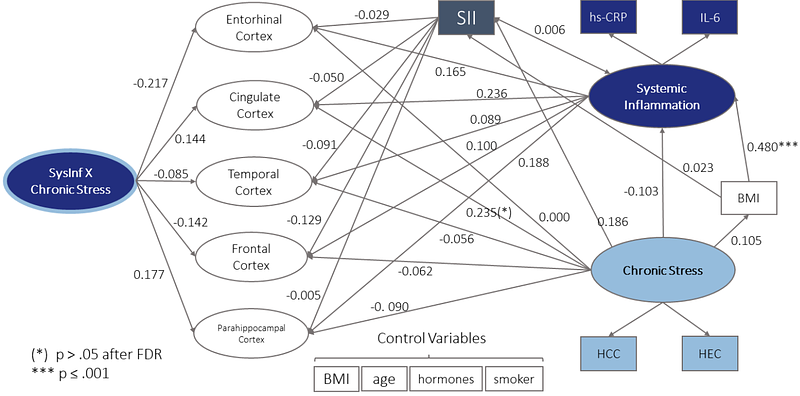Mapping Pathways to Neuronal Atrophy in Healthy, Mid-aged Adults: From Chronic Stress to Systemic Inflammation to Neurodegeneration?

Mapping Pathways to Neuronal Atrophy in Healthy, Mid-aged Adults: From Chronic Stress to Systemic Inflammation to Neurodegeneration?
Schaefer, J. K.; Engert, V.; Valk, S. L.; Singer, T.; Puhlmann, L. M.
AbstractGrowing evidence implicates systemic inflammation in the loss of structural brain integrity in natural ageing and disorder development. Chronic stress and glucocorticoid exposure can potentiate inflammatory processes and have also been linked to neuronal atrophy, particularly in the hippocampus and the human neocortex. To improve understanding of emerging maladaptive interactions between stress and inflammation, this study examined evidence for glucocorticoid- and inflammation-mediated neurodegeneration in healthy midaged adults. N=169 healthy adults (mean age = 39.4, 64.5% female) were sampled from the general population in the context of the ReSource Project. Stress, inflammation and neuronal atrophy were quantified using physiological indices of chronic stress (hair cortisol and cortisone concentration), systemic inflammation (interleukin-6, high-sensitive C-reactive protein), the systemic inflammation index (SII), hippocampal volume (HCV) and cortical thickness (CT) in regions of interest. Structural equation models were used to examined evidence for pathways from stress and inflammation to neuronal atrophy. Model fit indices indicated good representation of stress, inflammation, and neurological data through the constructed models (CT model: robust RMSEA = 0.041, robust Chi Square = 910.90; HCV model: robust RMSEA < 0.001, robust Chi Square = 40.95). We replicated typical negative age-cortical thickness associations (Anterior cingulate cortex ({beta} =-0.51, p < .001), Parahippocampal Cortex (beta = -0.50, p = .012), Frontal Lobe (beta = -0.56, p < .001) and Temporal Lobe (beta = -0.61, p < .001). Among inflammatory indices, only the SII was positively associated with hair cortisol as one indicator of chronic stress (beta = 0.18, p<.05). Direct and indirect pathways from chronic stress and systemic inflammation to cortical thickness or hippocampal volume were non-significant. We identify the SII as a potential marker of systemic inflammation in human psychobiological studies. More generally, these data suggest that neurophysiological associations found in at-risk populations are not detectable in healthy, mid-aged populations. We conclude that inflammation and glucocorticoid-mediated neurodegeneration may only emerge during advanced ageing and disorder processes and may thus have limited use as early risk markers. Future work should examine these pathways in prospective longitudinal designs, for which the present investigation serves as a baseline.